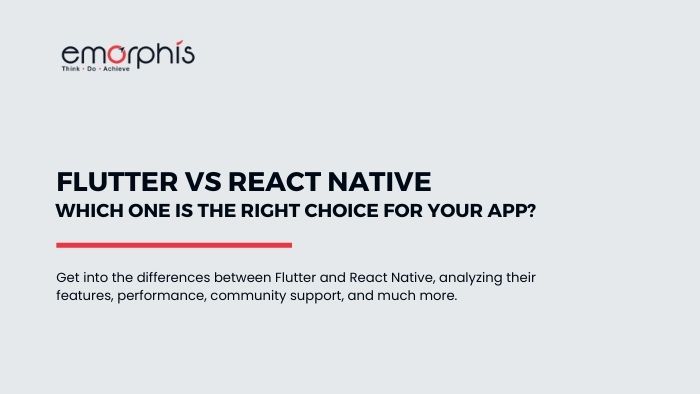In the ever-evolving landscape of mobile app development, choosing the right framework can make or break your project. Two of the most popular contenders in this space are Flutter vs React Native. Both are robust, widely used, and backed by tech giants—Google for Flutter and Facebook for React Native.
But which one is the right choice for your app?
In this article, we’ll dive deep into the differences between Flutter vs React Native, analyzing their features, performance, community support, and much more.
Overview of Flutter vs React Native
Flutter is Google’s open-source UI toolkit that enables developers to build natively compiled applications for mobile, web, and desktop from a single codebase. It uses the Dart programming language and focuses on creating visually stunning applications with customizable widgets.

React Native, on the other hand, is Facebook’s open-source framework that allows developers to create cross-platform mobile apps using JavaScript and React. It provides a native-like experience by leveraging platform-specific components, making it highly efficient for app development.
Find the details by clicking on the link of Flutter app development services and React Native app development services.
Market Presence of Flutter vs React Native
Flutter and React Native are widely used frameworks, each with a unique market presence and customer base. According to 6sense reports, the following details showcase the market share of both.
Flutter currently boasts 15,608 customers, capturing an estimated 0.68% market share, ranking it #12 in the application development segment. Flutter’s primary appeal lies in its ability to streamline web development (912 customers), software development (896 customers), and digital marketing (576 customers). Geographically, India leads with 3,221 customers (31.93%), followed closely by the United States with 3,041 customers (30.15%) and Brazil with 804 customers (7.97%).
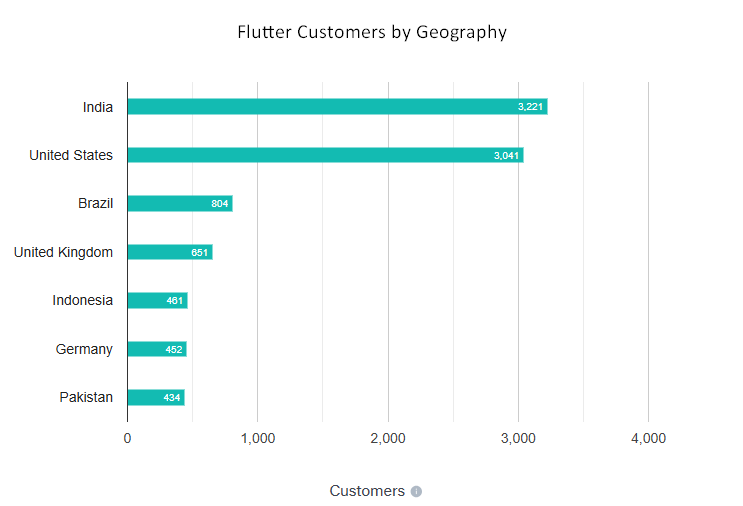
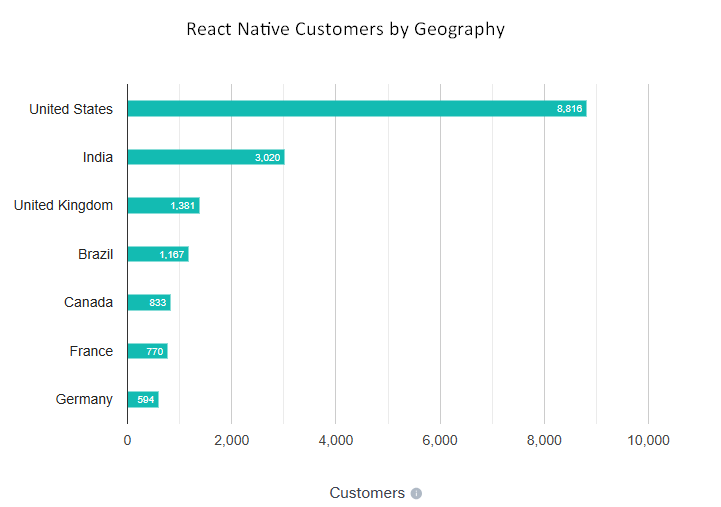
React Native, on the other hand, has a slightly larger customer base of 25,420, accounting for 0.67% market share and ranking it #19 in the libraries and widgets category. React Native primarily serves customers in software development (1,306), web development (1,301), and machine learning (671). The United States dominates React Native’s market with 8,816 customers (48.86%), followed by India with 3,020 customers (16.74%) and the United Kingdom with 1,381 customers (7.65%).
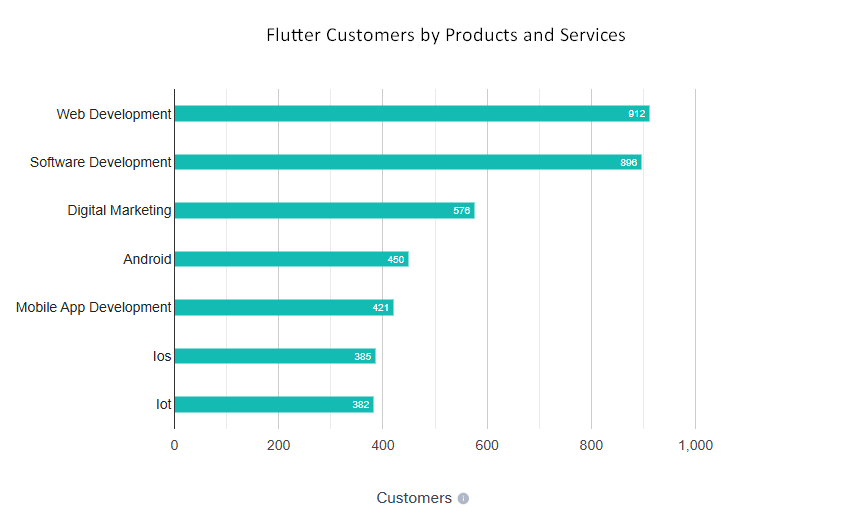
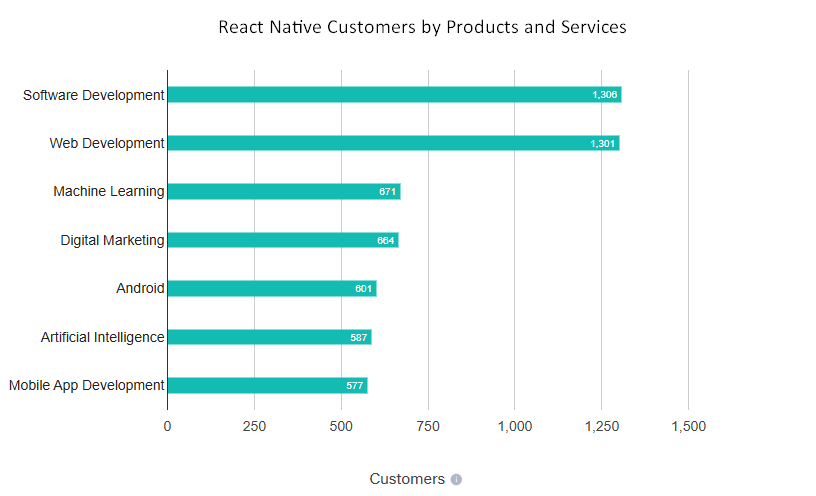
- Report on Flutter – https://6sense.com/tech/application-development/flutter-market-share
- Report on React native – https://6sense.com/tech/libraries-and-widgets/react-native-market-share
While both frameworks share overlapping use cases, their geographic distribution and adoption in specific services highlight unique strengths in the global development ecosystem.
Key Differences – Flutter vs React Native
1. Programming Languages: Dart vs JavaScript
One of the primary differences in Flutter vs React Native lies in the programming languages they use.
- Flutter:
- Flutter uses Dart, a less commonly used language compared to JavaScript.
- Dart is fast, easy to learn, and suitable for object-oriented programming.
- However, because Dart is not as popular as JavaScript, the developer pool for Flutter might be relatively smaller.
- React Native:
- React Native uses JavaScript, one of the most widely used programming languages in the world.
- In fact, the popularity of JavaScript ensures a vast talent pool and numerous libraries, making it easier to find resources for React Native projects.
- Because JavaScript is widely adopted, React Native often feels like a more familiar option for developers.
2. Performance Comparison
When discussing Flutter vs React Native, performance is a critical factor.
- Flutter Performance:
- Flutter compiles to native machine code, resulting in fast performance.
- It does not rely on a JavaScript bridge, which minimizes performance bottlenecks.
- Because of its custom rendering engine, Flutter provides consistent performance across platforms, making animations smoother and more fluid.
- React Native Performance:
- React Native uses a JavaScript bridge to communicate with native components, which can cause slight delays in performance, especially for complex applications.
- In fact, this bridge-based architecture can lead to inefficiencies, although these are often negligible for small to medium-sized apps.
- While Flutter has the upper hand in raw performance, React Native’s performance is generally sufficient for most use cases.
3. UI and Design Flexibility
The user interface (UI) is a crucial aspect of app development. Let’s compare Flutter vs React Native in terms of UI flexibility.
- Flutter UI:
- Flutter provides a rich set of pre-designed widgets that mimic the look and feel of both iOS and Android apps.
- These widgets are customizable, ensuring developers can create highly polished UIs.
- As a matter of fact, Flutter’s rendering engine ensures that the UI looks identical on different platforms, reducing inconsistencies.
- React Native UI:
- React Native relies on native UI components, which makes apps look and feel closer to the platform they’re running on.
- Because React Native depends on native libraries, developers often have to bridge components for highly customized designs, which can add to development time.
- Flutter’s widget-based architecture offers more flexibility for custom UI creation, but React Native’s native component approach provides a more platform-specific feel.
4. Community and Ecosystem
When comparing Flutter vs React Native, community support plays a significant role in decision-making.
- Flutter Community:
- Flutter’s community is growing rapidly, as Google actively supports the framework.
- However, because it is newer compared to React Native, its ecosystem is still maturing.
- React Native Community:
- React Native has been around longer, and because of this, it boasts a larger community and a more extensive ecosystem.
- The availability of third-party libraries and plugins for React Native far surpasses Flutter.
In fact, React Native’s mature ecosystem can be a deciding factor for projects requiring extensive third-party integrations.
5. Learning Curve
Another critical aspect of Flutter vs React Native is the learning curve for developers.
- Flutter:
- Learning Dart can be challenging for developers who are new to the language.
- Also, Flutter’s widget-heavy approach requires developers to understand its unique framework deeply.
- React Native:
- React Native is relatively easier to learn because JavaScript is already well-known among developers.
- Additionally, developers familiar with React for web development can quickly adapt to React Native.
6. Development Tools and Testing
The tools available for development and testing significantly impact the developer experience when working with Flutter vs React Native.
- Flutter Tools:
- Flutter comes with Flutter DevTools, which provides a robust suite of debugging and performance analysis tools.
- Because of its tight integration with the Dart language, Flutter simplifies testing with built-in support for unit, widget, and integration tests.
- React Native Tools:
- React Native offers debugging tools like React Developer Tools and Chrome DevTools.
- However, testing in React Native often requires third-party libraries, as the framework does not provide as comprehensive built-in support as Flutter.
7. Code Reusability and Hot Reload
- Flutter:
- Flutter offers a “hot reload” feature that allows developers to see changes in real-time without restarting the app.
- Code reusability is highly efficient because the same Dart codebase can be used across iOS, Android, web, and even desktop platforms.
- React Native:
- React Native also supports hot reload, though it occasionally encounters stability issues with complex apps.
- While React Native allows for significant code sharing across platforms, certain platform-specific features may still require separate implementation, increasing complexity.
8. Native Integration and Hardware Access
- Flutter:
- Flutter has excellent support for accessing device hardware through plugins. However, developers might need to write custom platform-specific code for certain native features.
- Flutter’s approach relies heavily on Google’s ecosystem, which may make it less straightforward to integrate with some non-Google-native tools.
- React Native:
- React Native has superior native integration, as it utilizes actual native components.
- Because React Native relies on native modules, accessing hardware features such as GPS, camera, and Bluetooth is more seamless for iOS and Android.
9. Startup Time
- Flutter:
- Apps built with Flutter can have longer initial startup times because of its larger binary size and the use of its rendering engine.
- This can be a limitation for applications where fast launch times are critical.
- React Native:
- React Native apps generally have faster startup times compared to Flutter because they rely on native components rather than a custom rendering engine.
10. App Size
- Flutter:
- Flutter apps tend to have larger file sizes due to the inclusion of the Flutter engine and built-in widgets.
- Because of this, apps built in Flutter may not be ideal for environments where minimizing app size is a priority.
- React Native:
- React Native apps typically have smaller sizes as they rely on native components already present in the device’s OS.
- This makes React Native a better choice for lightweight applications.
11. Maturity and Stability
- Flutter:
- Flutter is relatively newer and is evolving rapidly. While Google consistently updates it, some features and plugins might not yet be fully mature or stable.
- Because Flutter is still in the growth phase, frequent changes in its ecosystem can occasionally disrupt development.
- React Native:
- React Native has been around longer, and its ecosystem is more mature.
- It has a proven track record for large-scale, stable app development, as seen in apps like Instagram and Airbnb.
12. Web and Desktop Support
- Flutter:
- Flutter officially supports web and desktop applications, allowing developers to create truly cross-platform applications.
- Because Flutter has built-in support for web and desktop, it can be a strong contender for multi-platform app development.
- React Native:
- React Native primarily focuses on mobile platforms. While third-party solutions like React Native for Windows and macOS exist, they are not as robust or official as Flutter’s offerings for web and desktop.
13. Animation and Graphics
- Flutter:
- Flutter excels at creating high-quality, complex animations because it uses its own rendering engine, Skia.
- Because of its widget-based architecture, custom animations and graphics are easier to implement and highly consistent.
- React Native:
- React Native supports animations, but developers often rely on third-party libraries such as React Native Reanimated.
- In fact, creating highly customized animations in React Native can require additional effort and expertise.
14. Backward Compatibility
- Flutter:
- Flutter maintains strong backward compatibility, ensuring apps built with earlier versions of Flutter continue to work as expected with newer updates.
- React Native:
- React Native updates can sometimes break backward compatibility, requiring developers to make adjustments to keep apps functional.
- This can lead to additional maintenance overhead in long-term projects.
15. Enterprise Adoption
- Flutter:
- Flutter is being adopted by enterprises for projects requiring visually rich applications. Companies like Alibaba and Google Ads use Flutter.
- It’s particularly popular for startups and projects where a unified experience across platforms is a priority.
- React Native:
- React Native has been widely adopted by enterprise-level companies like Facebook, Instagram, and Walmart.
- Because of its maturity, enterprises feel more confident choosing React Native for mission-critical applications.
16. Plugin Availability
- Flutter:
- Flutter’s plugin ecosystem is growing but still catching up to React Native in terms of variety.
- In fact, for niche or specialized requirements, developers may need to create their own Flutter plugins.
- React Native:
- React Native boasts a vast plugin library, thanks to its older and larger community.
- Because of the extensive availability of plugins, React Native simplifies the development of feature-rich applications.
17. Support for Older Devices
- Flutter:
- Flutter apps are rendered entirely using its engine, ensuring consistent performance even on older devices.
- Because it does not rely on platform-specific components, Flutter often outperforms React Native on legacy devices.
- React Native:
- React Native depends on native components, which can lead to compatibility issues on older OS versions.
- However, developers can address these issues with additional effort by including fallbacks.
Differences Between Flutter and React Native
| Criteria | Flutter | React Native |
|---|---|---|
| Programming Language | Uses Dart, developed by Google. | Uses JavaScript, widely used and known. |
| Performance | High performance due to Skia rendering engine, delivering smooth animations. | Near-native performance, but relies on JavaScript bridge for UI updates. |
| UI and Design Flexibility | Offers a consistent UI with its own widget library for cross-platform uniformity. | Relies on native components, offering a native-like feel but less consistent UI. |
| Community and Ecosystem | Growing community, but smaller compared to React Native. | Mature ecosystem with a larger community and extensive library support. |
| Learning Curve | Requires learning Dart, which is less commonly used. | Easier to adopt if you’re familiar with JavaScript or React. |
| Development Tools | Rich IDE support with tools like Android Studio, IntelliJ, and VS Code. | Well-supported by IDEs and tools like VS Code, Atom, and WebStorm. |
| Testing | Provides robust testing support for unit, widget, and integration tests. | Limited built-in testing; depends on third-party libraries for comprehensive testing. |
| Animation Support | Excellent animation support due to its native rendering engine. | Good animation support but not as seamless as Flutter’s. |
| Integration with Native Code | Allows seamless integration but requires Dart expertise for native APIs. | Supports easy integration with native code, leveraging JavaScript’s popularity. |
| Market Adoption | Gaining popularity, backed by Google, and widely adopted for Google products. | More widely adopted by startups and enterprises for cross-platform apps. |
| Best Use Cases | Apps with customized UI, animations, or cross-platform consistency. | Apps requiring rapid development, native-like experience, or lightweight builds. |
| Geographic Popularity | Popular in India, United States, and Brazil. | Most popular in the United States, India, and the United Kingdom. |
| Integration with Google Services | Excellent support for Firebase, Google Cloud, and Maps. | Works with Google services but lacks the deep integration Flutter offers. |
| Ecosystem Ranking | Ranked #12 in app development. | Ranked #19 in libraries and widgets. |
Use Cases: When to Choose Flutter vs React Native
Both Flutter and React Native excel in different scenarios, making the choice between them highly dependent on your project’s goals, technical requirements, and target audience. Below are specific use cases that highlight when to choose one framework over the other:
Choose Flutter If:
- You prioritize high-performance and seamless animations: Flutter’s Skia rendering engine ensures smooth and consistent animations, making it perfect for apps that require visually appealing and complex user interfaces. For example, e-commerce apps, gaming apps, or interactive education platforms benefit greatly from Flutter’s performance and animation capabilities.
- You need consistent UI across platforms: Flutter uses its own widget library, which means the UI and behavior are consistent across iOS, Android, web, and desktop. This makes Flutter an ideal choice for applications where uniformity and branding are critical, such as corporate apps, fintech solutions, or healthtech platforms.
- You prefer Google-backed technologies: If your project leverages other Google products like Firebase, Google Cloud, or Maps, Flutter provides seamless integration. Additionally, as a Google-backed framework, it’s an excellent choice for businesses that trust Google’s long-term support and innovation.
Choose React Native If:
- You need faster development with JavaScript: React Native’s reliance on JavaScript, a language widely known by developers, makes it a strong choice for projects requiring rapid development cycles. Startups or businesses with tight deadlines and small teams can launch MVPs or feature updates faster using React Native.
- You want a mature ecosystem with extensive library support: React Native’s larger community and rich ecosystem of third-party libraries simplify the implementation of advanced features such as real-time chat, social media integrations, and payment gateways. For instance, it’s a great fit for social networking apps, content-sharing platforms, and ride-hailing services.
- You are building a lightweight app with a native feel: React Native’s approach to using native components allows it to deliver apps that closely mimic the native experience. This makes it suitable for applications that demand a lightweight build but still offer a high-quality user experience, such as travel apps, fitness trackers, or simple productivity tools.
Conclusion
When it comes to Flutter vs React Native, there is no one-size-fits-all answer. Both frameworks have their strengths and weaknesses, and the choice depends on your project requirements, team expertise, and long-term goals.

In fact, while Flutter excels in performance, UI consistency, and testing, React Native shines in community support, third-party integrations, and familiarity for developers. By carefully evaluating the aspects discussed in this article, you can make an informed decision about whether Flutter vs React Native is the better fit for your app development journey.
Further, connect with Emorphis Technologies and find the details of the following services on the link of Flutter app development services and React Native app development services.
Also, further, you can read more on the same.
- Importance of React Native Development in Healthcare
- Why Choose Cross-Platform Mobile App Development?
- 20 Innovative Enterprise Mobile App Development Ideas for Business Success



